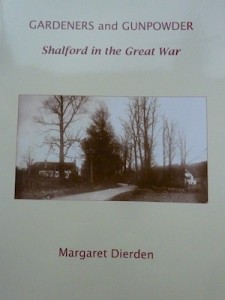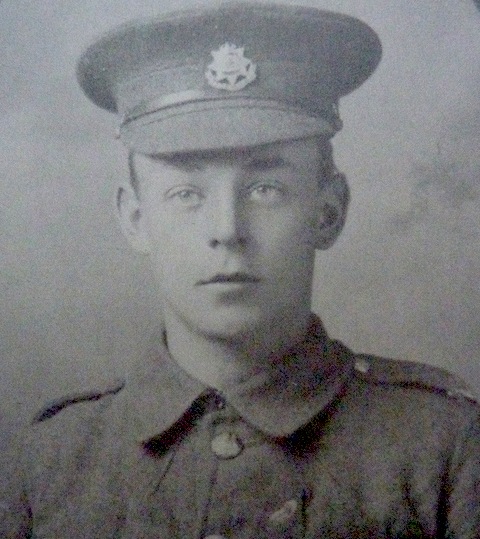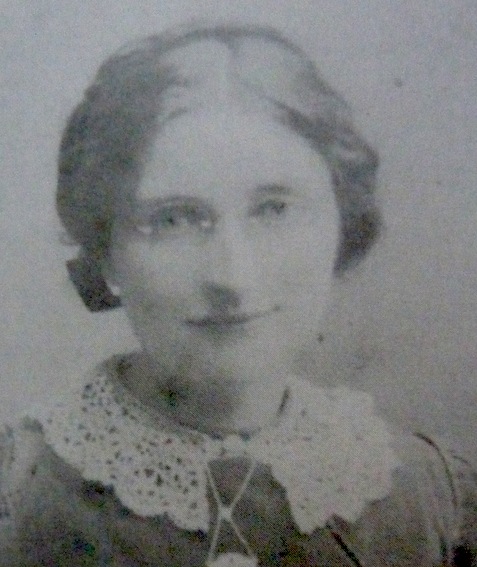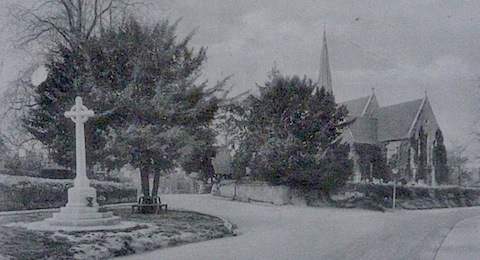 Abraham Lincoln
If given the truth, the people can be depended upon to meet any national crisis...
Abraham Lincoln
If given the truth, the people can be depended upon to meet any national crisis...
 Guildford news...
for Guildford people, brought to you by Guildford reporters - Guildford's own news service
Guildford news...
for Guildford people, brought to you by Guildford reporters - Guildford's own news service
Shalford In WWI – A Story Of Gardeners And Gunpowder
Published on: 5 Nov, 2014
Updated on: 5 Nov, 2014
Some years ago Shalford historian Margaret Dierden began researching the backgrounds of all those commemorated on the village’s war memorials.
 Such is her dedicated and detailed methods of research, she has uncovered truly fascinating stories relating to the First Word War and Shalford.
Such is her dedicated and detailed methods of research, she has uncovered truly fascinating stories relating to the First Word War and Shalford.
Of course, there is no-one alive now to give first-hand accounts, but, as she says in the foreword of her new book, “a brief snatch of their voices can still be heard in extracts from soldiers’ letters home printed in the Surrey Advertiser, as well as letters carefully preserved by families down the years”.
Added to those letters that she has had the pleasure of reading, Margaret has left no stone unturned in finding further details of Shalford and its people at the time – through official records at places including the Surrey History Centre, the National Archives, the Commonwealth War Graves Commission, as well as local school, church and Women’s Institute records and minutes.
Detail and dates of those men from the village who died are one thing, but her new book, Gardeners and Gunpowder Shalford in the Great War, goes much further that that. It is an exceptionally poignant read, in which the human side of the lives of those men and what life was like in the village while the war raged and its aftermath, come to the fore. You won’t have known these people personally, but reading about them will make you feel like you did!
Take the story of Ted Cutt of Peasmarsh. We learn that he was one of the first of Lord Kitchener’s volunteers from the village to die. Margaret tells the story of his enlistment into the 9th Battalion East Surrey Regiment and how he went into action on the September 26, 1915, the second day of the Battle of Loos, and went missing.
His story becomes more ‘real’, as Margaret adds that he had become engaged to Nellie Dabbs whose family Ted was billeted with when at a training camp at Shoreham in West Sussex. The book contains an illustration from Nellie’s notebook in which she wrote about her desperate search for news of him after he had gone missing. All she had to remember him by was a lock of his hair (a picture of which is also shown).
The book also charts the progress of the war on the home front in and around Shalford. The Zeppelin raid of 1915 is noted along with the ever-increasing role of women at that time. For example, working parties met each week at Shalford Village Hall to make sandbags to be used in the trenches.
Some women kept family businesses going. While her husband, BIll, worked as an aircraft engineer at Farnborough, Ellen Warne ran their bicycle and motor repair business in Kings Road.
Effects of the great influenza epidemic that began in the summer of 1918 were felt in Shalford. The book notes that “a quarter of the children of Shalford School were absent by 8 November and the school was closed…. Forty-one-year-old Alice Webber, the wife of John Webber, the blacksmith in Station Road, died along with her six-year-old son Sydney, leaving her husband with eight children, the youngest only a month old.”
The story of how Shalford’s war memorial cross came to be sited is given, along with details of others in the parish church.
However, the story does not end there as the book contains a wealth of information about the village post-war, giving an insight into the difficulties people had adjusting, and stories of some of those men who had served with the armed forces finding it hard to get work. Margaret tells how brothers Arthur and Basil Girdler toured racetracks making a meagre living from a ‘foolproof’ system of betting.
The book is packed with fascinating stories and more. It contains many pictures of Shalford people and places from the era and an appendix lists and gives details of 48 men who died between 1914-18 war and who were originally listed on Shalford’s war memorial, plus another 23 men who died and are associated with Shalford.
All this in an A4 size book of 126 pages at £7.95 is a must have.
Copies are available from Shalford Post Office, Guildford Museum, the Surrey History Centre, or direct from the author at 15 Tilehouse Road GU4 8AP (also the same price to include postage and packaging). Call 01483 503805 or email mdierden@btinternet.com
Responses to Shalford In WWI – A Story Of Gardeners And Gunpowder
Leave a Comment Cancel replyPlease see our comments policy. All comments are moderated and may take time to appear.
Recent Articles
- Guildford Institute’s Crowdfunding Project for Accessible Toilet in its New Community and Wellbeing Centre
- Letter: Guildford – Another Opportunity Missed?
- Letter: GBC’s Corporate Strategy – Where Is the Ambition?
- My Memories of John Mayall at a Ground-breaking Gig in Guildford Nearly Six Decades Ago
- Westborough HMO Plans ‘Losing the Heart of the Street’ Says Resident
- College Invests to Boost Surrey’s Economy and Close Digital Skills Gap
- Community Lottery Brings Big Wins for Local Charities
- GBC Housing Plan Promises ‘A Vibrant Urban Neighbourhood’ Near Town Centre
- Hospital Pillows ‘Shortage’ at the Royal Surrey
- Updated: Caravans Set Up Camp at Ash Manor School


Recent Comments
- Ian Macpherson on Updated: Main Guildford to Godalming Road Closed Until August 1
- Sara Tokunaga on GBC Housing Plan Promises ‘A Vibrant Urban Neighbourhood’ Near Town Centre
- Michael Courtnage on Daily Mail Online Reports Guildford Has Highest-paid Council Officer
- Alan Judge on GBC Housing Plan Promises ‘A Vibrant Urban Neighbourhood’ Near Town Centre
- John Perkins on GBC Housing Plan Promises ‘A Vibrant Urban Neighbourhood’ Near Town Centre
- S Collins on GBC Housing Plan Promises ‘A Vibrant Urban Neighbourhood’ Near Town Centre
Search in Site
Media Gallery
Dragon Interview: Local Artist Leaves Her Mark At One of England’s Most Historic Buildings
January 21, 2023 / No Comment / Read MoreDragon Interview: Lib Dem Planning Chair: ‘Current Policy Doesn’t Work for Local People’
January 19, 2023 / No Comment / Read MoreA3 Tunnel in Guildford ‘Necessary’ for New Homes, Says Guildford’s MP
January 10, 2023 / No Comment / Read More‘Madness’ for London Road Scheme to Go Ahead Against ‘Huge Opposition’, Says SCC Leader
January 6, 2023 / No Comment / Read MoreCouncillor’s Son Starts Campaign for More Consultation on North Street Plan
December 30, 2022 / No Comment / Read MoreCounty Council Climbs Down Over London Road Works – Further ‘Engagement’ Period Announced
December 14, 2022 / No Comment / Read MoreDragon Interview: GBC Reaction to the Government’s Expected Decision to Relax Housing Targets
December 7, 2022 / No Comment / Read MoreHow Can Our Town Centre Businesses Recover? Watch the Shop Front Debate
May 18, 2020 / No Comment / Read More












Angeline Litton
October 13, 2020 at 12:59 pm
Interesting to read the article about John Webber the Blacksmith Station road Shalford and his wife. John and Alice Webber are my grandparents.